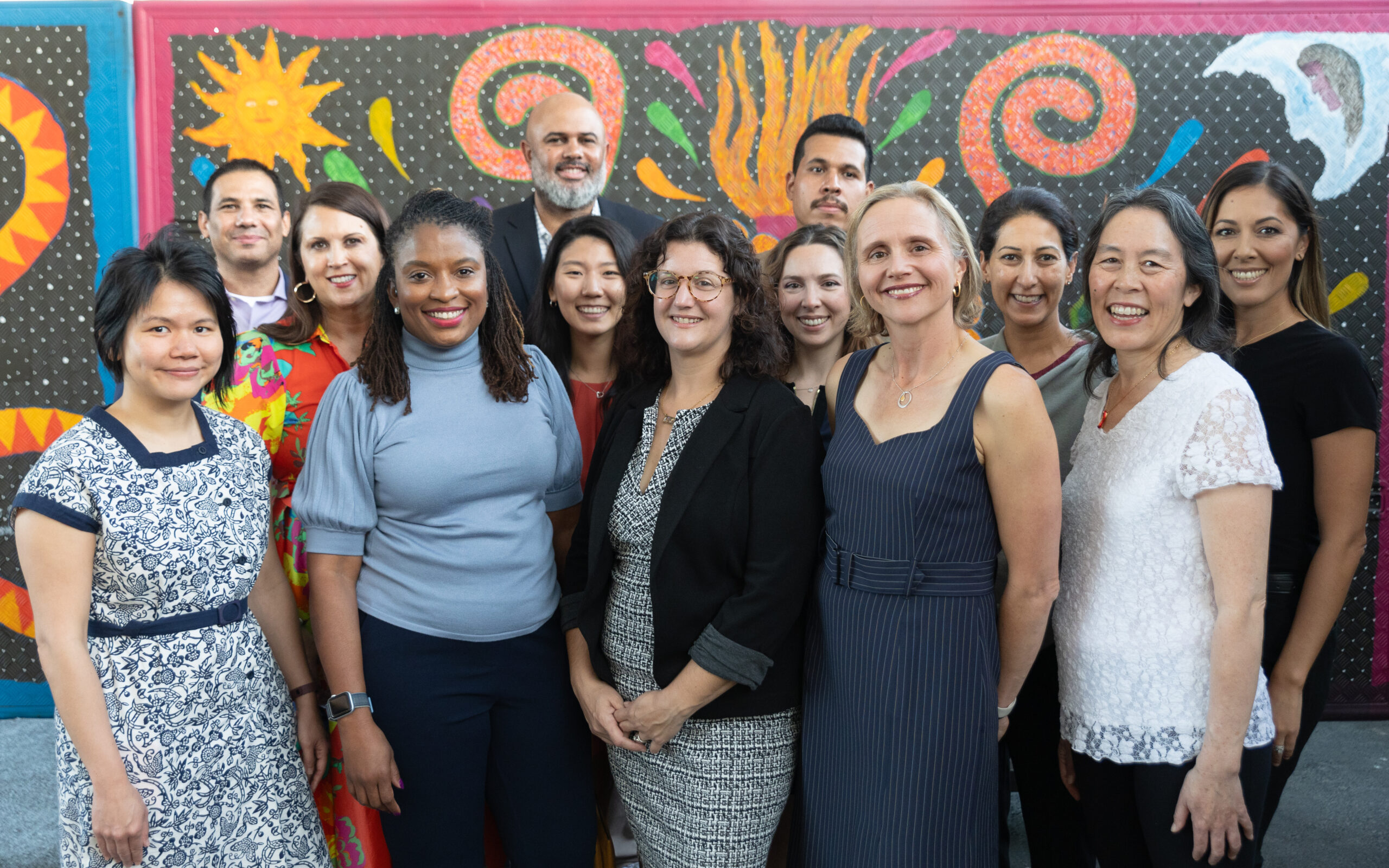
Event Spotlight: Insights from Bay Area Leaders on Family Involvement and Student Success
In October, we hosted our first event in Oakland, California, an exciting event that brought together educators, education leaders, parents, and community members for a special evening of conversation and connection.
At the event, we were honored to lead an education-focused panel with 5 Bay Area leaders. Edgility Co-Founder and Managing Partner Christina Greenberg was joined on stage by Terence Johnson (CEO, Caliber Schools), Karla Grandiaga (Directora, ARISE High School), Kimi Kean (Co-Founder & CEO, Families in Action for Quality Education), and Leroy Gaines (Network Superintendent, Oakland Unified School District).

Over the course of the discussion, these 4 brilliant leaders discussed the state of education in the Bay Area and explored ways parents and other guardians can get involved with their children’s education. If you’re a parent, teacher, or a school leader yourself you should take a moment to review a few of the key ideas from their discussion.
Panel Discussion Recap
Q. How can schools learn what parents/caregivers need?
Parents and caregivers inherently desire the best for their children, and thus need more than just information—they seek meaningful partnerships and tools for active participation in their children’s education. Recognizing their commitment during vulnerable moments and equipping them with communication tools fosters an environment of collaboration and inclusivity, meeting the evolving needs of parents effectively.
Our panelists suggested that school leaders engage in direct and honest conversations with caregivers, sharing insights, data, and expertise to establish transparency. For this partnership to work, it’s crucial to consider diverse perspectives when making decisions. Actively involving caregivers as essential partners in shaping their children’s educational experiences helps to create inclusive learning environments where all young people can thrive.
Q. How can schools foster transparency with parents and other family members?
It’s best to empower students and families through transparent communication and accessible tools. By leveraging platforms like iReady or Grad Tracker, schools can not only share achievements but also address challenges honestly and proactively, creating a foundation for collaborative problem-solving.
That said, student data can be hard to read and understand, even for some educators, so it’s crucial to demystify this complex information. Schools should do their best to avoid jargon and present data in a way that everyone can comprehend. This will ensure that parents feel empowered rather than overwhelmed. Moreover, schools should encourage questions and invest in staff training to equip educators with the skills to guide families through interpreting and utilizing the data effectively. Keep in mind that it may also be necessary to provide translation services for this as well.
Building a mutual community with parents or caregivers involves creating supportive systems. Empowering students to lead presentations about their assessment results, such as NWA scores, encourages parents to hear directly from their children about their academic progress and lean in as support at their student’s request.
Q. What are some exciting practices that encourage family and community participation?
A successful practice that may encourage family participation is the implementation of a comprehensive family leadership and partnership program. Recognizing that educators cannot handle everything alone, this approach invests time in empowering families to take active roles in their children’s education. Believing in the untapped potential of families, schools can initiate programs like academic mentorship and engage alumni within the school community. Establishing a student-to-educator program, which includes professional development opportunities, livable wages, and a structured education pathway for high school students, not only supports current students but also creates a sustainable pipeline of future educators.
To further encourage involvement, schools can organize parent/guardian-led classrooms, setting aside specific days for a non-educator adult to teach a class with support from the school’s family coordinator. This practice not only provides a unique perspective for caregivers but also turns them into valuable allies in the educational process. Incorporating literacy initiatives, such as “Lit for Literacy,” that demonstrate how to read and interpret data, and adopting a science-based approach to reading, creates an engaging and educational experience for families to observe in action. Lastly, prompting parents/guardians with thought-provoking questions about their aspirations for their children and seeking feedback on school initiatives further strengthens the bond between families and schools.
Q. How can we help parents/guardians who speak a variety of languages?
Supporting families who speak a variety of languages involves a multifaceted approach centered on effective communication and inclusivity. To address language diversity, institutions should prioritize the provision of interpretation services and the translation of essential materials. Leveraging interpretation devices and making academic mentors available as a resource can bridge language gaps, ensuring that parents receive crucial information in a format they can understand. Additionally, having a diverse, multilingual staff can facilitate in-house communication, fostering a welcoming and inclusive environment where parents from different linguistic backgrounds feel valued and understood.
To make these initiatives sustainable and impactful, it’s essential to prioritize language diversity when allocating funds. By earmarking resources specifically for interpretation services, translation efforts, and hiring multilingual staff, educational institutions demonstrate a commitment to meeting the unique needs of linguistically diverse families. This proactive approach not only breaks down language barriers but also fosters a sense of belonging and engagement for all parents, irrespective of their primary language. Ultimately, the goal is to create an educational community that recognizes and celebrates linguistic diversity, ensuring that parents from various language backgrounds are active participants in their children’s education.
Q. What programs do you suggest schools have in place for mental health and wellness?
In addition to staffing mental health professionals accessible to students, schools should actively cultivate a culture that encourages open dialogue about mental health. A first line of mental health check-ins prioritizes early intervention, creating an environment where students can comfortably address their well-being. The aim is to make conversations about mental health as commonplace as those about academics. Our panelists expressed the need for educators and school staff to demystify mental health check-ins for families, fostering understanding and emphasizing that parents are integral partners in their child’s mental health journey. This commitment extends to the adoption of restorative justice practices, seeking to resolve conflicts within the school community in a manner that promotes healing, understanding, and a supportive atmosphere for all. The core ethos is that mental health isn’t merely a program; it’s a cultivated culture celebrated daily.
Q. How should schools manage frequent absences from students?
Amid the challenges posed by increased student absences, particularly exacerbated by the ongoing COVID-19 situation, schools are adopting multifaceted strategies to address this issue. Our panelists’ focus is not solely on the quantitative aspect, such as the increase in Average Daily Attendance (ADA), but on a more qualitative engagement. In an effort to understand the root causes, educators are making home visits, reframing the conversation from a disciplinary tone to one of genuine concern—asking not just “why aren’t you here?” but, more importantly, “Is everything okay?” This shift aims to create a supportive environment that acknowledges the complex realities students may be facing outside the school walls. Parents/guardians must be brought into the conversation as well. As families become more involved, leaders have seen more parents reach out to other parents and encourage them to make sure their students are attending school.
A critical aspect of this process involves getting explicit about the consequences of prolonged absences. It’s important to emphasize that attendance is not just about academic performance, but about fostering a sense of belonging and connection, which is particularly crucial for older students. Schools actively promote opportunities for students to connect beyond the classroom, recognizing the significance of interpersonal relationships. ARISE, with an innovative approach, dedicates Mondays to enrichment activities rather than regular classes, fostering interactions with different adults, and encouraging students to step outside their comfort zones. The key message is clear: schools must make students feel noticed and valued.
Special thanks to our amazing panelists!
- Terence Johnson, CEO, Caliber Schools
- Karla Grandiaga, Directora, ARISE High School
- Kimi Kean, Co-Founder & CEO, Families in Action for Quality Education
- Leroy Gaines, Network Superintendent, Oakland Unified School District





Event photos by Darren Raveneau





